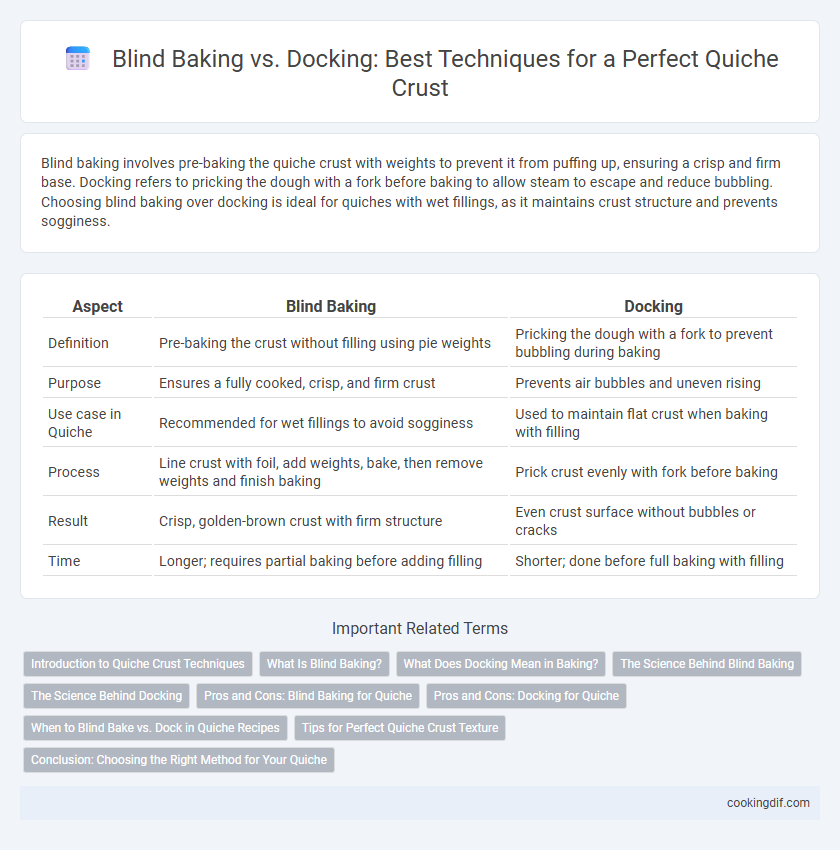Blind baking involves pre-baking the quiche crust with weights to prevent it from puffing up, ensuring a crisp and firm base. Docking refers to pricking the dough with a fork before baking to allow steam to escape and reduce bubbling. Choosing blind baking over docking is ideal for quiches with wet fillings, as it maintains crust structure and prevents sogginess.
Table of Comparison
| Aspect | Blind Baking | Docking |
|---|---|---|
| Definition | Pre-baking the crust without filling using pie weights | Pricking the dough with a fork to prevent bubbling during baking |
| Purpose | Ensures a fully cooked, crisp, and firm crust | Prevents air bubbles and uneven rising |
| Use case in Quiche | Recommended for wet fillings to avoid sogginess | Used to maintain flat crust when baking with filling |
| Process | Line crust with foil, add weights, bake, then remove weights and finish baking | Prick crust evenly with fork before baking |
| Result | Crisp, golden-brown crust with firm structure | Even crust surface without bubbles or cracks |
| Time | Longer; requires partial baking before adding filling | Shorter; done before full baking with filling |
Introduction to Quiche Crust Techniques
Blind baking involves pre-baking the quiche crust with pie weights or beans to prevent shrinking and ensure a crisp, fully cooked base for custard filling. Docking requires piercing the dough surface with a fork to create small holes that allow steam to escape, reducing puffing during baking. Both techniques are essential for achieving a flaky, stable crust in classic quiche recipes like Quiche Lorraine or vegetable quiches.
What Is Blind Baking?
Blind baking is the process of pre-baking a quiche crust without filling to prevent sogginess and ensure a crisp, golden base. It involves lining the pastry with parchment paper or foil and filling it with pie weights or dried beans to maintain shape during baking. This technique is essential for custard-based quiches where the filling requires a shorter baking time than the crust.
What Does Docking Mean in Baking?
Docking in baking involves pricking small holes in the quiche crust with a fork to allow steam to escape, preventing bubbles and uneven rising during baking. Unlike blind baking, which pre-cooks the crust to maintain a firm base, docking helps maintain the dough's structure without fully cooking it beforehand. This technique ensures a crisp, flat crust ideal for holding rich fillings like custard or vegetables in quiche recipes.
The Science Behind Blind Baking
Blind baking a quiche crust involves pre-baking the pastry without filling to prevent sogginess by setting the structure of the dough. This process uses heat to gelatinize starches and coagulate proteins in the flour and butter, creating a stable barrier that resists moisture from the filling. Docking punctures the dough to release steam and prevent bubbles but does not provide the same structural reinforcement as blind baking, which is essential for achieving a crisp and firm quiche crust.
The Science Behind Docking
Docking quiche crust involves piercing the dough with a fork to create small holes, allowing steam to escape during baking and preventing the crust from puffing up. This technique controls moisture buildup and promotes even heat distribution, ensuring a crisp, evenly baked crust essential for a perfect quiche base. Unlike blind baking, which uses weights to hold down the dough, docking relies on vapor pressure regulation to maintain the crust's structural integrity.
Pros and Cons: Blind Baking for Quiche
Blind baking a quiche crust ensures a crisp, fully cooked base by pre-baking it before adding the filling, preventing sogginess caused by moist custard. This method helps maintain the crust's structure, especially with wet fillings, but requires careful monitoring to avoid over-browning or shrinking. However, blind baking adds time and the need for pie weights, which can complicate preparation compared to docking, a simpler technique that may not prevent soggy crusts as effectively.
Pros and Cons: Docking for Quiche
Docking a quiche crust involves puncturing the dough with a fork to allow steam to escape, which helps prevent bubbling and uneven rising during baking. This method is less effective at stopping sogginess compared to blind baking because the liquid filling may still seep into the crust, but it saves time and effort since no pre-baking is required. Docking works well for quiches with thicker fillings or when a slightly softer crust texture is acceptable.
When to Blind Bake vs. Dock in Quiche Recipes
Blind baking quiche crust is essential when the filling is wet or requires a longer cooking time than the crust, ensuring a crisp, fully cooked base without sogginess. Docking, or pricking small holes in the dough, is best for recipes with shorter baking times and less liquid fillings to prevent air bubbles and uneven rising. Choosing between blind baking and docking depends on the moisture content and baking duration of the quiche filling for optimal crust texture.
Tips for Perfect Quiche Crust Texture
Blind baking quiche crust involves pre-baking the crust with pie weights to prevent shrinking and ensure a crisp base, essential for a perfectly textured quiche. Docking, or pricking the dough with a fork, allows steam to escape during baking, reducing bubbles and uneven puffing in thinner crusts. Combining both techniques--blind baking with pie weights followed by strategic docking--yields a crisp, flaky crust ideal for holding creamy quiche fillings without sogginess.
Conclusion: Choosing the Right Method for Your Quiche
Blind baking involves pre-baking the quiche crust with weights to prevent bubbling, ensuring a crisp, fully cooked base ideal for custard fillings. Docking punctures the dough with a fork to allow steam to escape, reducing puffing but may result in a less firm crust. For a perfectly textured quiche, blind baking is recommended when a sturdy crust is essential, while docking suits quiches with high-moisture toppings that require less crust firmness.
Blind baking vs docking for quiche crust Infographic

 cookingdif.com
cookingdif.com